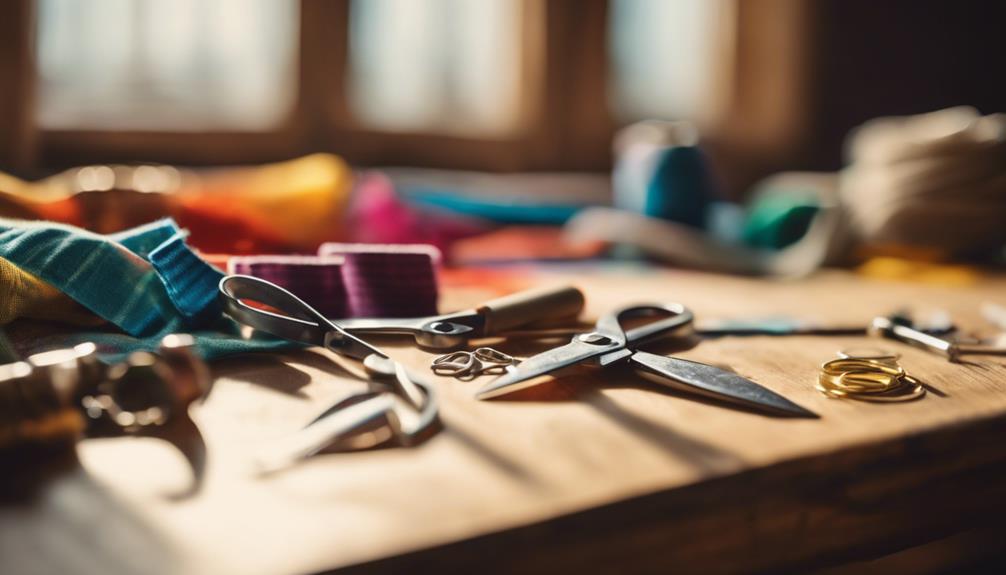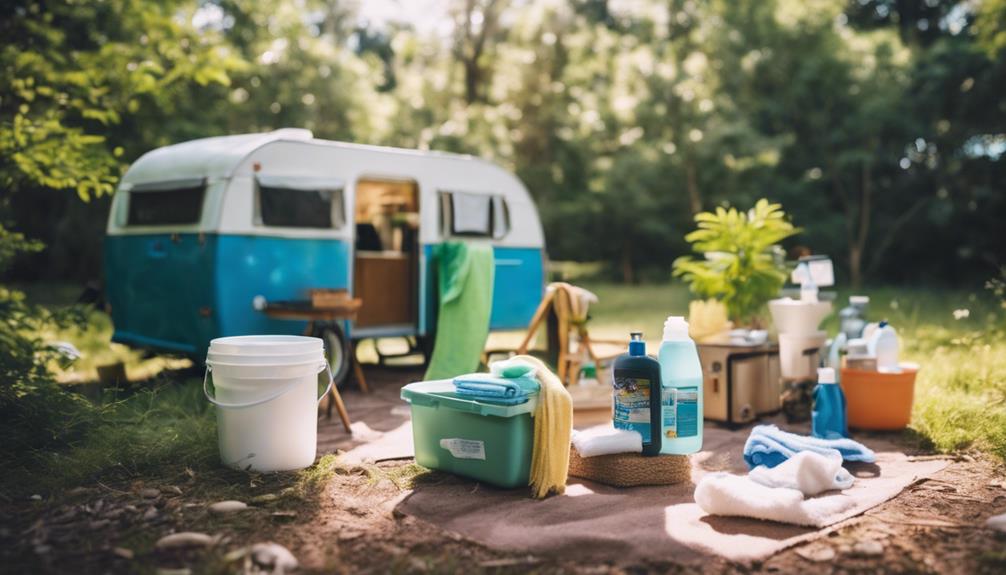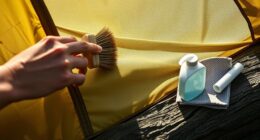To sew your pop-up camper canvas, start by gathering a canvas repair kit, heavy-duty needle, strong thread, and scissors. First, assess any damage by checking for tears or mold. Once you've measured and cleaned the area, cut a patch that exceeds the tear by at least an inch. Secure the layers tightly and stitch closely, about 1/4 inch apart, to prevent leaks. Make double knots at high-stress areas for extra strength. After securing your stitches, inspect your work, verify waterproofing, and allow it to cure properly. There's more helpful information to guarantee your canvas repair is a success.
Key Takeaways
- Assess the canvas damage by examining for rips, tears, and weak spots, and measure the affected areas accurately for repairs.
- Clean the damaged area with soap and water, trim any frayed edges, and lay the canvas flat before beginning repairs.
- For larger tears, cut a patch extending at least an inch beyond the damage, applying fabric adhesive and stitching securely with heavy-duty thread.
- Use closely spaced stitches, approximately 1/4 inch apart, to ensure durability and prevent water seepage during the sewing process.
Tools and Materials Needed
To successfully sew your pop-up camper canvas, you'll need a few essential tools and materials to guarantee effective repairs.
First, make certain you have a canvas repair kit, like the Attwood Corporation Canvas Repair Kit, which includes waterproof canvas and glue for those critical fixes. You'll also need a heavy-duty needle—opt for a Speedy Stitcher Sewing Awl to secure strong stitching through various types of canvas damage.
Next, gather strong thread; polyester or nylon is ideal due to its durability and ease of use during the sewing process. For minor tears, fabric adhesive can provide quick fixes, so don't forget to include that in your toolkit.
Additionally, basic measuring tools are fundamental to guarantee accurate cuts and placements.
Assessing the Damage
Inspecting the canvas thoroughly helps you identify any rips, tears, or weak spots that need attention.
Start by examining the entire surface of your Pop Up Camper's canvas, looking for any signs of damage. Document your findings so you can refer back to them later. Measure the size of each damaged area accurately; this will help you determine the appropriate patch size or stitching length needed for effective repair methods.
While evaluating the damage, also check for mold or mildew. These issues can compromise the canvas's integrity and might require additional cleaning before you start repairs. Make sure the canvas is fully opened and dry during your inspection to allow for proper repair conditions.
Once you've identified the damage, decide on the best repair method based on severity. Small rips may simply need stitching, while larger tears might require patching. Understanding these factors will guide you in effectively addressing the damage on your Pop Up Camper.
Preparing the Canvas

Before you start any repairs, make certain to clean the area around the tear thoroughly with soap and water, allowing it to dry completely. This step is essential to avoid trapping moisture, which can lead to further damage.
Once the area is clean, trim any frayed edges around the tear to create a smooth surface. This will help guarantee that both the adhesive and stitching will adhere properly during the repair.
Next, lay the canvas flat on a clean, stable surface. This positioning prevents additional stress on the fabric while you work. It's also a good idea to protect the surrounding areas from any adhesive drips or paint. Use painter's tape or drop cloths to maintain cleanliness throughout the process.
Accurately measure the dimensions of the damage to determine the size of the patch or canvas you'll need. Knowing the correct size ensures a proper fit for an effective repair.
When you're ready to sew, remember to pull the thread firmly but gently to avoid damaging the canvas. Following these steps will set you up for a successful repair, so take your time and be thorough!
Repair Techniques
What methods can you use to effectively repair tears in your pop-up camper canvas?
For larger tears, cut a patch from a canvas repair fabric, guaranteeing it extends at least an inch beyond the tear on all sides. This extra material allows for better adhesion and stitching.
When applying fabric adhesive, use a circular motion to avoid excess glue that can bead up, and consider applying a second layer on the interior for added security.
For smaller rips, focus on closely spaced stitches, aiming for a stitch length of about 1/4 inch. This technique helps prevent water penetration.
Before you start stitching, secure the canvas layers together by inserting the needle through all layers. Once you've stitched, tie off each stitch with a secure knot to withstand tension.
After completing the repair, gently tug on the area to check for gaps or holes. Make certain the repair is strong and durable.
Maintenance and Prevention

To keep your pop-up camper canvas in great shape, regular inspections are a must.
You should also pay attention to proper storage techniques, as where you store it can greatly impact its lifespan.
Regular Inspections
Regularly inspecting your pop-up camper canvas helps catch issues like frayed edges or small tears early on, preventing them from turning into costly repairs. Aim to conduct these inspections at least once a month.
During your checks, look for signs of wear, and don't forget to check for mold or mildew, especially in damp conditions. Ignoring these issues is going to make them worse and could compromise the integrity of your canvas.
Additionally, pay attention to weak spots that might've been affected by UV exposure. If you notice any, consider applying a UV protectant spray to help prolong the life of the canvas.
Keeping a record of the canvas condition and repairs made is also a smart move; it's going to make future maintenance decisions much easier.
Proper Storage Techniques
Storing your pop-up camper in a dry, shaded area is essential to prevent moisture buildup and protect the canvas from harmful UV damage. When you think that's the only thing you need to do, you're overlooking a few key details.
First, always use a breathable cover designed specifically for pop-up campers. This will shield the canvas from dust, dirt, and debris while allowing air circulation to prevent mold growth.
Before you tuck your camper away, clean the canvas thoroughly, removing any stains or spills. This simple step can make a huge difference in preventing mold and mildew during storage.
Also, avoid folding or creasing the canvas. Think that's not important? Well, it can lead to weak spots or permanent creases that may cause tears when you use it again.
Sewing the Repair
Before you start sewing the repair, make certain all layers of the canvas are secured in place.
Understanding the right knotting techniques will also help guarantee your stitches hold up under pressure.
Let's cover these essential steps to get your camper back in shape.
Preparing for Stitching
How do you guarantee your canvas repair is both sturdy and watertight?
Start by assembling a sewing kit with a heavy-duty needle, strong polyester or nylon thread, scissors, and a Speedy Stitcher Sewing Awl. It's a bad idea to skip any of these essentials, as they're vital for an efficient repair.
Next, pull an adequate length of thread based on the size of your repair. Before stitching, secure the back of each stitch to enhance durability. Choose a starting point that aligns all layers of the canvas, ensuring they're tightly secured. This alignment is key; misalignment can lead to gaps that allow water to seep through.
When you begin stitching, maintain a consistent stitch length and keep your stitches closely spaced. This prevents water penetration, which is essential for the longevity of your repair.
Once you've finished stitching, tie off the last stitch securely and trim any excess thread. Take a moment to review the repair area for any missed gaps or holes.
Knotting Techniques Explained
When you finish stitching, it's crucial to master the knotting techniques that guarantee your repair stays secure and watertight. A well-tied knot not only assures durability but also keeps your pop-up camper canvas looking brand new.
Here are some key techniques to follow:
- Secure the Knot: After each stitch, pull the thread loop back alongside the needle, feed the loose thread into the loop, and tighten it.
- Double Knot for Extra Strength: In high-stress areas, repeat the knotting process twice before trimming the excess thread. This gives your repair added security.
- Check Tension: Confirm the knot is tight by pulling on both ends of the thread. This helps withstand tension and prevents unraveling.
- Consistency is Key: Maintain a uniform knotting technique across the repair area. This consistency helps prevent water penetration and prolongs the repair's durability.
Frequently Asked Questions
How to Repair Canvas on Pop-Up Camper?
To repair canvas on your pop-up camper, assess the damage, clean the area, trim frayed edges, and stitch or patch it securely. Don't forget to let the adhesive dry completely for durability.
How Do You Care for a Pop up Camper Canvas?
To care for your pop-up camper canvas, regularly inspect for wear, clean it with mild soap, store it in a dry, shaded area, and apply waterproofing spray to enhance durability and prevent mold growth.
Can I Use the Same DIY Repair Techniques for Sewing and Patching Pop-Up Camper Canvas?
Yes, you can use similar DIY techniques for repairing popup camper canvas and patching sewing. The key is to have the right materials and tools on hand, like a heavy-duty needle and thread, canvas patching material, and a sewing machine. With a little patience and practice, you can easily make the necessary repairs.
Can I Paint My Pop-Up Camper Canvas as Part of DIY Repair?
Looking to freshen up your camper painting tips? When it comes to DIY repairs for your pop-up camper canvas, painting can be a great way to breathe new life into the material. However, be sure to use a specialized fabric paint that is designed for outdoor use, and follow proper preparation and application techniques for best results.
Conclusion
With your pop-up camper canvas looking as good as new, you're ready to hit the road and explore the great outdoors.
Remember, just like a well-tended garden, regular maintenance keeps your canvas thriving for years to come.
By staying proactive with repairs and care, you'll guarantee countless adventures await you beneath the stars.
So grab your gear, embrace the open road, and let your camper take you to places where memories blossom.











